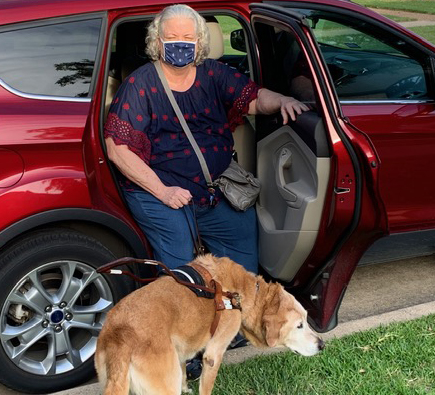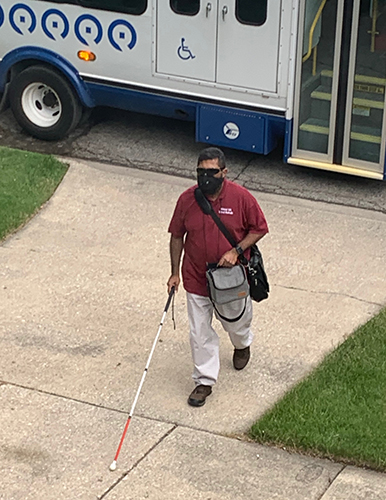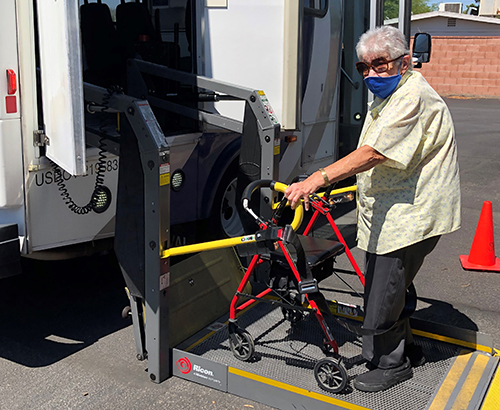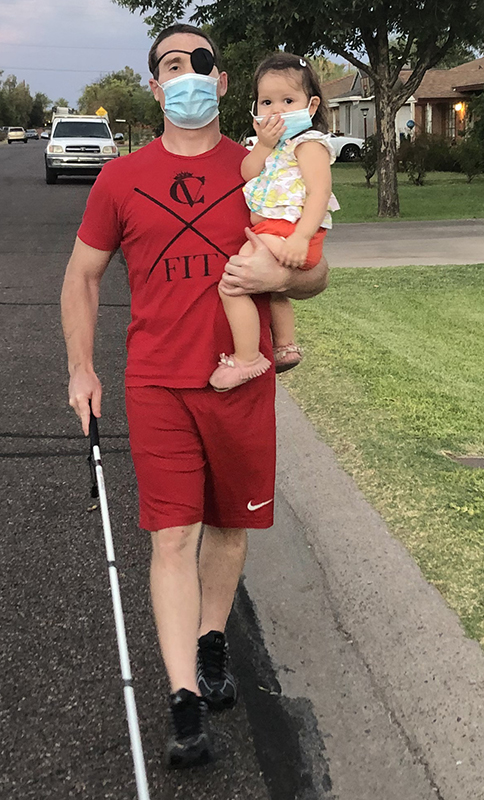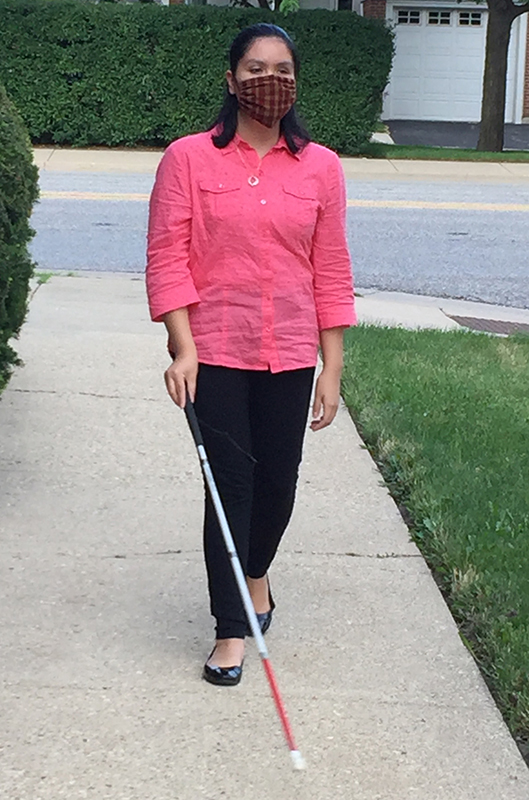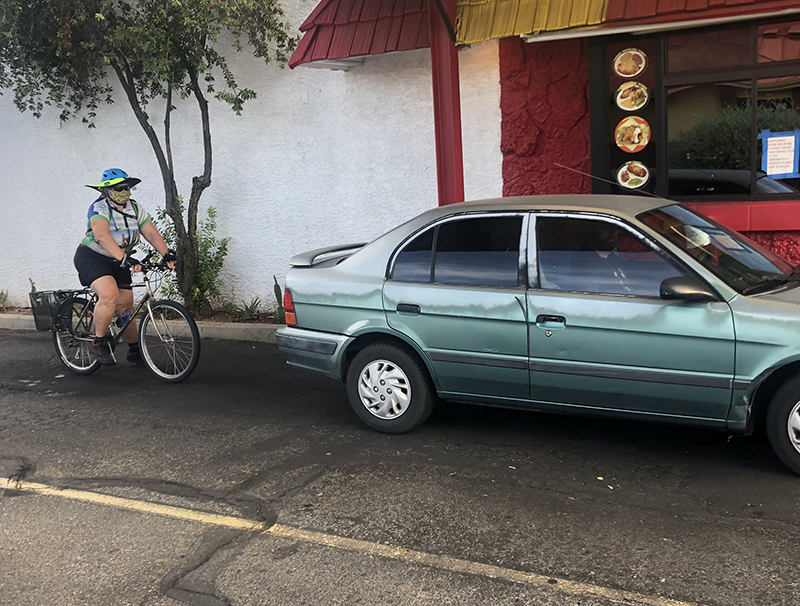Transportation has been one of my greatest fears during all of this. I don't want to risk all of the germs in an Uber, not to mention there are less drivers. Things like buses and trains have been shut down.
—Adult-onset VI White male, aged 65 to 74 years, with no additional disabilities
Access to reliable, affordable, and efficient transportation is a systemic issue for people who are visually impaired. The COVID-19 pandemic has increased transportation challenges for those who are visually impaired due to a combination of factors, including service reductions, policy changes, and concerns about safety. Of the 1,921 participants, 1,162 (63%) had concerns about transportation due to COVID-19 and answered questions about this topic, 84 (5%) had concerns about transportation but did not choose to answer questions, and 587 (32%) did not have concerns about transportation.
Participants provided their level of agreement to 11 concern statements. 8
- Due to the COVID-19 pandemic, I do not feel safe taking public transit (e.g., bus, subways). (n=1,072, M=4.36, SD=0.95)
- I am concerned that because I do not drive, I will not be able to get myself or a family member to a COVID-19 test center. (n=1,115, M=4.24, SD=1.06)
- Due to the COVID-19 pandemic, I do not feel safe taking taxis. (n=1,0 47, M=4.19, SD=1.0 0)
- I am concerned that because I do not drive, I will not be able to get myself or a family member to a hospital or healthcare facility if they have severe COVID- symptoms. (n=1,107, M=4.18, SD=1.11)
- I am concerned that due to the COVID-19 pandemic my community has restricted or will soon restrict public transit, paratransit, taxis, and/or rideshare services such as Uber or Lyft. (n=1,101, M=4.17, SD=1.01)
- Due to the COVID-19 pandemic, I do not feel safe taking paratransit. (n=918, M=4.12, SD=1.06)
- Due to the COVID-19 pandemic, I do not feel safe using rideshare services such as Uber or Lyft. (n=1,094, M=4.07, SD=1.07)
- I am concerned that because I do not drive, I will have difficulty getting groceries or other key essentials. (n=1,105, M=3.86, SD=1.19)
- I am concerned that due to the COVID-19 pandemic my community has stopped public transit, paratransit, taxis, and/or rideshare services such as Uber or Lyft. (n=857, M=3.45, SD=1.25)
- I am concerned that when I use public transportation I am being required to enter and/or exit at the rear of the bus. (n=740, M=3.34, SD=1.21)
- I am concerned that due to my reduced work hours, being laid off, or the business I worked for closing, I can no longer afford to use the transportation methods I have used in the past. (n=433, M=3.28, SD=1.36)
Transportation to Access Healthcare
During a pandemic, knowing whether one has the virus is at the forefront of people's minds. For those who are nondrivers, getting tested for COVID-19 and potentially needing transportation to a facility for treatment caused extreme anxiety and concern for many participants. These frustrations stemmed from many transportation services no longer allowing passengers with certain symptoms to use the service.
In addition, individuals themselves reported they did not want to endanger a driver or fellow passengers by using a transportation service if they had COVID-19 symptoms. Many participants expressed frustration about officials having no alternative testing options or recommendations for how to get to a facility, other than by ambulance.
Participants were asked to rate their level of agreement with the statement: "I am concerned that because I do not drive, I will not be able to get myself or a family member to a hospital or healthcare facility if they have severe COVID-19 symptoms." Of the participants who rated this statement more females (55%) than males (25%) expressed they agreed or strongly agreed, and those 55 years and older had the highest concern (33%) among the three age categories. Participants with a congenital vision loss (51%) had greater concern than those with a childhood vision loss (11%) or vision loss during adulthood (17%). This statement was of higher concern to those who were blind (53%) compared with those with low vision (26%). There was a higher level of concern for participants who did not have an additional disability (44%) compared with those who did have an additional disability (36%).
I am not sure how I would get to a mobile testing site. I wouldn't feel comfortable using public transportation or ride-share services for fear of backlash or spreading [COVID-19].
—Congenitally VI Black or African American female, aged 35 to 44 years, with no additional disabilities
Safety When Using Transportation
For some participants, their safety concerns related to transportation included
- not being able to social distance in the vehicle,
- not being able to tell if others were wearing masks,
- not knowing who had been in the vehicle prior to them and the health status of previous riders, and
- not being able to judge the cleanliness of the vehicle.
There were a few participants who expressed concerns about transportation stemming from their personal characteristics beyond their visual impairment, such as their ethnic identity or additional disabilities.
I am also Asian, and with the rise in hate crimes and discrimination against Asian-Americans, I am afraid to use public transportation or rideshare in fear of getting hurt or denied access.
—Congenitally VI Asian female, aged 25–34 years, with no additional disabilities
Table 2 shows the number and percent of participants who strongly agreed/agreed to the following: "Due to the COVID-19 pandemic, I do not feel safe taking [form of transportation]."
Most participants who expressed a strong concern about using public transit, taxis, paratransit, and rideshare services were congenitally visually impaired, White, female, aged 55 years or older, and did not have any additional disabilities.
Participants were asked to rate their level of agreement with the statement: "I am concerned that because I do not drive, I will not be able to get myself or a family member to a COVID-19 test center." Of the participants who rated this statement more females (57%) than males (24%) expressed they agreed or strongly agreed, and those 55 years and older had the highest concern (33%) among the three age categories. Participants with a congenital vision loss (52%) had greater concern than those with a childhood vision loss (12%) or vision loss during adulthood (18%). This statement was of higher concern to those who were blind (56%) compared with those with low vision (26%). There was a higher level of concern for participants who did not have an additional disability (44%) compared with those who did have an additional disability (37%).
The Effect of Policies and Scheduling on Transportation Use
Policies enacted by bus companies to have passengers board the bus through the rear door have placed a burden on riders. For some, their physical needs resulting from their visual impairment or another disability, such as arthritis, inhibits their ability to climb stairs. For others, not having access to speak with the bus driver to confirm information or ask a question presents challenges. Though participants recognized the need for drivers to maintain their own personal safety, they felt that a balance needed to be struck so they could board through the front door if needed or speak to the driver.
When they are [strapping my power chair down], they have no choice [but] to get close, which is understandable. The thing that I didn't like is [the driver] never either changed his gloves from when he was driving the bus to when he strapped me down. ... [In my opinion, he needed to] wipe the straps and area down to clean anything that I may have to touch like a handle for stability.
—Congenitally VI White male, aged 35 to 44 years, with additional disabilities
Participants were asked to rate their level of agreement with the statement: "I am concerned that when I use public transportation I am being required to enter and/or exit at the rear of the bus." Of the participants who rated this statement more females (26%) than males (15%) expressed they agreed or strongly agreed. Participants with a congenital vision loss (26%) had greater concern than those with a childhood vision loss (7%) or vision loss during adulthood (8%). This statement was of higher concern to those who were blind (28%) compared with those with low vision (13%). There was little difference in the level of concern for participants by presence of an additional disability.
We do have to enter and exit at the rear of the city bus, which can be difficult. They tell you not to touch the railing, but I have to hold the railing in order to try to gauge depth perception since I use a dog rather than a cane.
—Adult-onset VI White female, aged 35 to 44 years, with no additional disabilities
In some communities, transportation options have been discontinued or schedules have been limited, which directly affects the ability of those with visual impairments to travel, shop, go to work, access healthcare, etc. Although transportation restrictions due to stay-at-home orders are understandable, people will still have an occasion to leave their homes. For many who are visually impaired, access to transportation is essential to meet basic needs or to perform duties as essential workers.
Some study participants speculated about how having access to an autonomous (self-driving) vehicle would enable them to maximize their independence while limiting their exposure to others during transit.
Participants were asked to rate their level of agreement with the statement: "I am concerned that due to the COVID-19 pandemic my community has restricted or will soon restrict public transit, paratransit, taxis, and/or rideshare services such as Uber or Lyft." Of the participants who rated this statement more females (53%) than males (24%) expressed they agreed or strongly agreed, and those 55 years and older had the highest concern (31%) among the three age categories. Participants with a congenital vision loss (50%) had greater concern than those with a childhood vision loss (10%) or vision loss during adulthood (17%). This statement was of higher concern to those who were blind (52%) compared with those with low vision (25%). There was a higher level of concern for participants who did not have an additional disability (44%) compared with those who did have an additional disability (33%).
About 2 weeks ago, the local bus transit arbitrarily, with only 24-hour's notice, changed how passengers access buses. Passengers must now enter at the back door and self-distance. I stopped using the buses and now walk 1.5 miles to work and 1.5 miles back home each weekday as I have essential work duties that [require me] to be on site. ... I feel like walking is best to keep proper distance, but want our leaders to know that some of us with visual impairments have essential job duties that require us to still go to the job site every weekday to gladly do our part.
—Adult-onset VI White male, aged 55 to 64 years, with additional disabilities
Recommendations
People who are visually impaired are workers; provide care to others and need to access healthcare themselves; go to school and have children who attend school; and need access to food and other supplies. Transportation related concerns were expressed by almost all of the participants in the study. Improvements to transportation would dramatically affect mobility and increase full community participation for those with vision loss, both during the COVID-19 pandemic and long term.
- Transportation providers should establish community advisory committees that include people with disabilities and solicit input on specifics to ensure those with visual impairments are as comfortable as possible using services.
- Transportation providers and local governments must plan for transportation service alternatives for those who are disabled when services in a community are limited or discontinued in an emergency. If fixed-route service is suspended, access to accessible non-shared ride on-demand services may improve access to critical services and jobs.
- Transportation planning should be inclusive of people with disabilities and go beyond minimum accessibility requirements. Long-term investments should include transportation access in underserved areas, including rural areas, as well as accessible, navigable sidewalks that connect people to services, transportation hubs, and their destination.
- Transit agencies can mitigate concerns about cleanliness of vehicles or if drivers are wearing masks by adjusting service so that social distancing is possible on transit vehicles, by clearly communicating how and when vehicles will be cleaned, by providing personal protective equipment to drivers, and by making masks available to passengers who do not have their own.
- Companies and public agencies need to consider those with disabilities, as they develop autonomous vehicles for buses or personal travel. Vehicles must be fully accessible.
- Services, such as COVID-19 testing sites or food banks, must recognize not everyone in need of their services has a vehicle and can participate in the "drive-through" option. Alternatives must be provided for community members to access these services on site by allowing community members to walk up. In addition, for those who cannot travel into the community, optional service delivery practices must be established.
- Public transit agencies must make their apps and websites fully accessible to those who are visually impaired. Information posted on apps and websites must be immediately accessible to riders.
- Public transit agencies must release updates in a timely manner, ideally several days before implementation, to allow riders enough time to plan their trips.
- When enacting policies such as rear-door boarding on buses, public transportation companies and policymakers must recognize that there are often negative ramifications of these changes. Policies should ensure that people who need certain features of public transportation, such as front door boarding, close access to the driver, or wheelchair lifts, are able to access these features safely.
I have some real concerns about getting to testing if I need to be evaluated or hospitalized. My health insurance provider has helped me develop a plan to address some of these [needs], but transportation is a constant concern—to the extent of researching options in my area in case I am infected.
—Adult-onset VI White female, aged 75 years or older, with no additional disabilities
8. The mean (M) is derived by averaging the participants' ratings, strongly disagree (1) to strongly agree (5). The larger the standard deviation (SD) the greater the spread from the mean of the participants' ratings.
